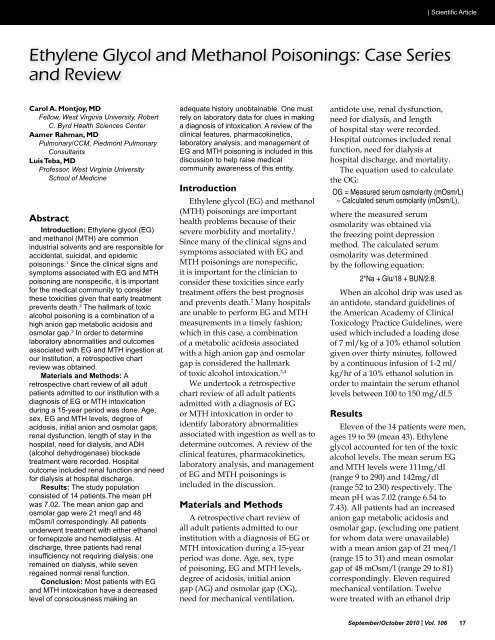September/October - West Virginia State Medical Association
September/October - West Virginia State Medical Association
September/October - West Virginia State Medical Association
Create successful ePaper yourself
Turn your PDF publications into a flip-book with our unique Google optimized e-Paper software.
| Scientific Article<br />
Ethylene Glycol and Methanol Poisonings: Case Series<br />
and Review<br />
Carol A. Montjoy, MD<br />
Fellow, <strong>West</strong> <strong>Virginia</strong> University, Robert<br />
C. Byrd Health Sciences Center<br />
Aamer Rahman, MD<br />
Pulmonary/CCM, Piedmont Pulmonary<br />
Consultants<br />
Luis Teba, MD<br />
Professor, <strong>West</strong> <strong>Virginia</strong> University<br />
School of Medicine<br />
Abstract<br />
Introduction: Ethylene glycol (EG)<br />
and methanol (MTH) are common<br />
industrial solvents and are responsible for<br />
accidental, suicidal, and epidemic<br />
poisonings. 1 Since the clinical signs and<br />
symptoms associated with EG and MTH<br />
poisoning are nonspecific, it is important<br />
for the medical community to consider<br />
these toxicities given that early treatment<br />
prevents death. 2 The hallmark of toxic<br />
alcohol poisoning is a combination of a<br />
high anion gap metabolic acidosis and<br />
osmolar gap. 3 In order to determine<br />
laboratory abnormalities and outcomes<br />
associated with EG and MTH ingestion at<br />
our institution, a retrospective chart<br />
review was obtained.<br />
Materials and Methods: A<br />
retrospective chart review of all adult<br />
patients admitted to our institution with a<br />
diagnosis of EG or MTH intoxication<br />
during a 15-year period was done. Age,<br />
sex, EG and MTH levels, degree of<br />
acidosis, initial anion and osmolar gaps,<br />
renal dysfunction, length of stay in the<br />
hospital, need for dialysis, and ADH<br />
(alcohol dehydrogenase) blockade<br />
treatment were recorded. Hospital<br />
outcome included renal function and need<br />
for dialysis at hospital discharge.<br />
Results: The study population<br />
consisted of 14 patients.The mean pH<br />
was 7.02. The mean anion gap and<br />
osmolar gap were 21 meq/l and 48<br />
mOsm/l correspondingly. All patients<br />
underwent treatment with either ethanol<br />
or fomepizole and hemodialysis. At<br />
discharge, three patients had renal<br />
insufficiency not requiring dialysis; one<br />
remained on dialysis, while seven<br />
regained normal renal function.<br />
Conclusion: Most patients with EG<br />
and MTH intoxication have a decreased<br />
level of consciousness making an<br />
adequate history unobtainable. One must<br />
rely on laboratory data for clues in making<br />
a diagnosis of intoxication. A review of the<br />
clinical features, pharmacokinetics,<br />
laboratory analysis, and management of<br />
EG and MTH poisoning is included in this<br />
discussion to help raise medical<br />
community awareness of this entity.<br />
Introduction<br />
Ethylene glycol (EG) and methanol<br />
(MTH) poisonings are important<br />
health problems because of their<br />
severe morbidity and mortality. 1<br />
Since many of the clinical signs and<br />
symptoms associated with EG and<br />
MTH poisonings are nonspecific,<br />
it is important for the clinician to<br />
consider these toxicities since early<br />
treatment offers the best prognosis<br />
and prevents death. 2 Many hospitals<br />
are unable to perform EG and MTH<br />
measurements in a timely fashion;<br />
which in this case, a combination<br />
of a metabolic acidosis associated<br />
with a high anion gap and osmolar<br />
gap is considered the hallmark<br />
of toxic alcohol intoxication. 3,4<br />
We undertook a retrospective<br />
chart review of all adult patients<br />
admitted with a diagnosis of EG<br />
or MTH intoxication in order to<br />
identify laboratory abnormalities<br />
associated with ingestion as well as to<br />
determine outcomes. A review of the<br />
clinical features, pharmacokinetics,<br />
laboratory analysis, and management<br />
of EG and MTH poisonings is<br />
included in the discussion.<br />
Materials and Methods<br />
A retrospective chart review of<br />
all adult patients admitted to our<br />
institution with a diagnosis of EG or<br />
MTH intoxication during a 15-year<br />
period was done. Age, sex, type<br />
of poisoning, EG and MTH levels,<br />
degree of acidosis, initial anion<br />
gap (AG) and osmolar gap (OG),<br />
need for mechanical ventilation,<br />
antidote use, renal dysfunction,<br />
need for dialysis, and length<br />
of hospital stay were recorded.<br />
Hospital outcomes included renal<br />
function, need for dialysis at<br />
hospital discharge, and mortality.<br />
The equation used to calculate<br />
the OG:<br />
OG = Measured serum osmolarity (mOsm/L)<br />
– Calculated serum osmolarity (mOsm/L),<br />
where the measured serum<br />
osmolarity was obtained via<br />
the freezing point depression<br />
method. The calculated serum<br />
osmolarity was determined<br />
by the following equation:<br />
2*Na + Glu/18 + BUN/2.8.<br />
When an alcohol drip was used as<br />
an antidote, standard guidelines of<br />
the American Academy of Clinical<br />
Toxicology Practice Guidelines, were<br />
used which included a loading dose<br />
of 7 ml/kg of a 10% ethanol solution<br />
given over thirty minutes, followed<br />
by a continuous infusion of 1-2 ml/<br />
kg/hr of a 10% ethanol solution in<br />
order to maintain the serum ethanol<br />
levels between 100 to 150 mg/dl.5<br />
Results<br />
Eleven of the 14 patients were men,<br />
ages 19 to 59 (mean 43). Ethylene<br />
glycol accounted for ten of the toxic<br />
alcohol levels. The mean serum EG<br />
and MTH levels were 111mg/dl<br />
(range 9 to 290) and 142mg/dl<br />
(range 52 to 230) respectively. The<br />
mean pH was 7.02 (range 6.54 to<br />
7.43). All patients had an increased<br />
anion gap metabolic acidosis and<br />
osmolar gap, (excluding one patient<br />
for whom data were unavailable)<br />
with a mean anion gap of 21 meq/l<br />
(range 15 to 31) and mean osmolar<br />
gap of 48 mOsm/l (range 29 to 81)<br />
correspondingly. Eleven required<br />
mechanical ventilation. Twelve<br />
were treated with an ethanol drip<br />
<strong>September</strong>/<strong>October</strong> 2010 | Vol. 106 17















